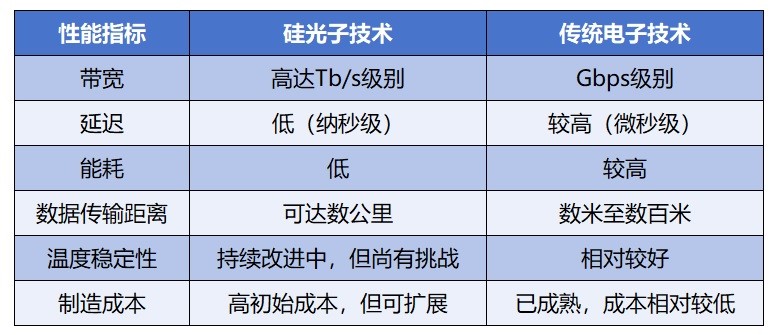In the modern semiconductor industry, with the rapid increase in the demand for data processing, the physical limitations of traditional electronic devices are gradually emerging, and the search for alternative technologies is becoming more and more demanding. In this context, Silicon Photonics has become an area of interest, which combines optical communication with silicon-based semiconductor technology to provide the possibility to solve the bottleneck problem of high-speed data transmission. In this article, China Exportsemi will try to deeply discuss the development of silicon photonics technology, its application prospects in the semiconductor industry, and the challenges it faces.
Ⅰ. Overview of silicon photonics technology
Silicon photonics is a technology that integrates photonics devices on a silicon substrate and uses optical signals instead of electronic signals for data transmission. Conventional electronics rely on the transmission of electrical signals through conductors, which are limited by resistance and capacitance when traveling over long distances, resulting in signal attenuation and energy loss. In contrast, optical signals are transmitted in optical fibers or silicon-based waveguides with little to no loss, enabling high-bandwidth, low-latency high-speed data transmission.

Figure: Silicon photonics technology compared to conventional electronic technology
The core principle of silicon photonics is to use silicon as an optical material and use its transparency in the infrared band to enable optical signals to be freely transmitted in silicon-based waveguides. Since silicon is a basic material in the semiconductor industry, silicon photonics technology can be compatible with existing semiconductor manufacturing processes, such as CMOS processes, greatly reducing manufacturing costs.
Ⅱ. Key components of silicon photonics technology
Silicon photonic chips are made up of multiple optical components, each of which plays a key role in the generation, transmission, modulation, and detection of optical signals. The following are the main components in silicon photonics technology:
1. Light Source
Silicon is not an ideal light source material on its own, because the indirect bandgap structure of silicon limits its light emission efficiency. For this reason, an external light source, such as an integrated laser, is often required to generate the optical signal. This light source is typically made using III-V semiconductor materials, such as gallium arsenide (GaAs) or indium phosphide (InP), and is bonded or integrated into a silicon chip.
2. Optical Modulators
Optical modulators are used to convert electrical signals into optical signals. Commonly used modulation techniques include electro-optic modulation (e.g., Mach-Zehnder modulator) and thermo-optic modulation. The advantage of electro-optical modulators is that they are fast and suitable for high-speed data transmission scenarios.
3. Waveguide
Silicon-based waveguides are at the heart of silicon photonics technology, which is responsible for directing optical signals through the chip. Silicon has a low absorption rate at near-infrared wavelengths (e.g., 1550nm), which makes it an ideal material for optical signal transmission.
4. Photodetector
The role of a photodetector is to convert an optical signal into an electrical signal. In silicon photonic chips, germanium (Ge) is often used as a photodetector material because it can effectively absorb infrared light signals and produce a current response.
5. Optical separators and couplers
Optical separators are used to split a beam of light into multiple beams, or to combine multiple beams of light into a single beam. The coupler is responsible for coupling the optical signal into the waveguide, or the optical signal in the waveguide back to the fiber.

Figure: Key devices and their functions for silicon photonics
Ⅲ. Application scenarios of silicon photonics technology
Silicon photonics technology has shown great potential in several areas, especially in data centers, 5G communications, sensing, and high-performance computing.
1. Data Centers
With the rise of cloud computing and big data, data centers have a growing demand for bandwidth and energy efficiency. Traditional data center architectures rely heavily on copper cables for data transmission, however, as data volumes grow, the energy efficiency and bandwidth of copper cables are no longer sufficient. Silicon photonics technology offers a more efficient solution that significantly increases data transfer rates while reducing energy consumption. At present, many large data center operators around the world have begun to introduce silicon photonics-based optical interconnection technology for high-speed data transmission between servers.
2. 5G communication
The high-speed, low-latency, and large-connectivity characteristics of 5G networks have significantly increased their reliance on fiber optic communications. Especially in the backhaul link between the base station and the core network, fiber communication has become a necessity. The high bandwidth and low latency of silicon photonics technology make it play an important role in the infrastructure of 5G networks. In addition, silicon photonics technology can also be used to generate and modulate mmWave signals, further driving the performance of 5G networks.
3. High Performance Computing (HPC)
In the field of high-performance computing, bottlenecks in data transmission often limit the overall performance of the system. Silicon photonics technology enables high-speed and low-latency optical interconnection between processors, memory, and storage devices, breaking the limitations of traditional electronic interconnection and improving computing efficiency. In the future, with the development of quantum computing and supercomputing, silicon photonics technology is expected to become one of the core technologies in HPC systems.
4. Sensing & Medical
Silicon photonics technology is also widely used in optical sensors and medical devices. For example, in optical coherence tomography (OCT) devices, silicon photonic chips enable high-resolution imaging. In addition, silicon photonics technology can be used in areas such as environmental sensing, chemical analysis, and biomedical testing.
Related:What is Silicon Photonics (2)






